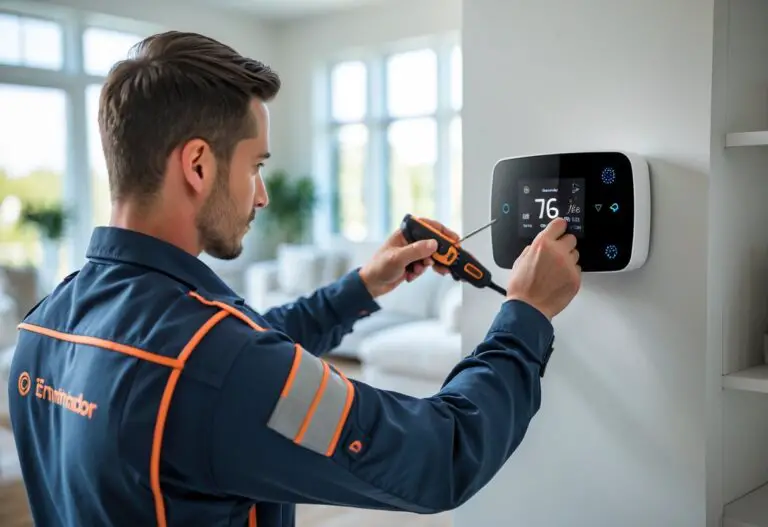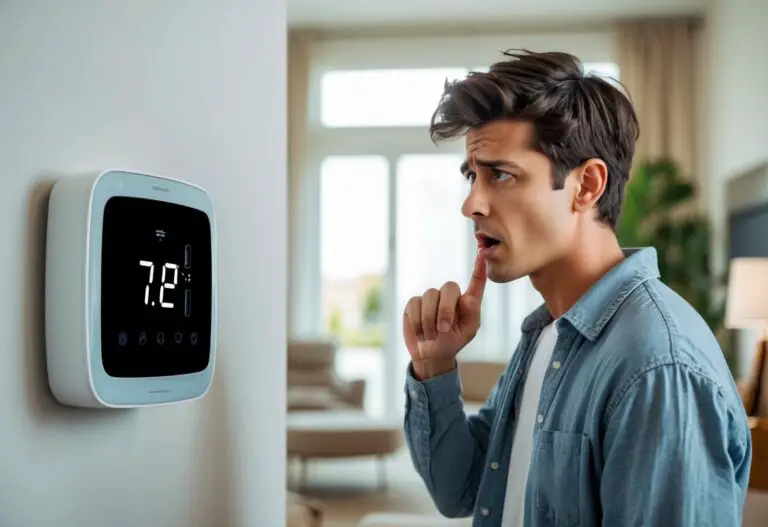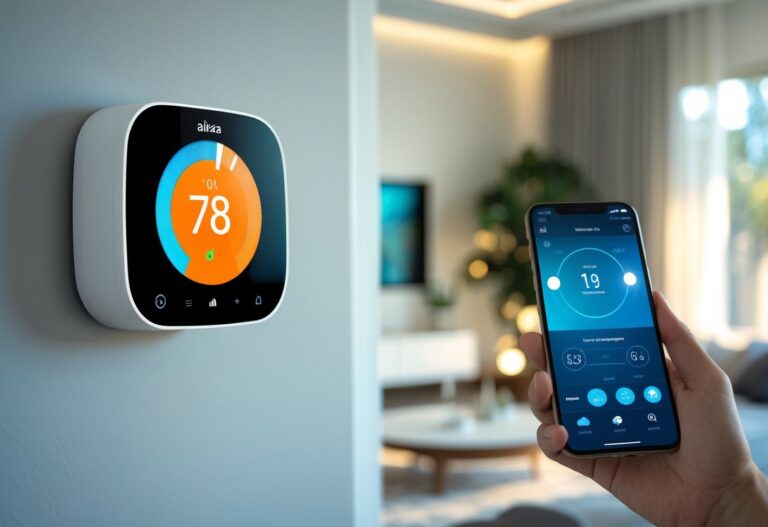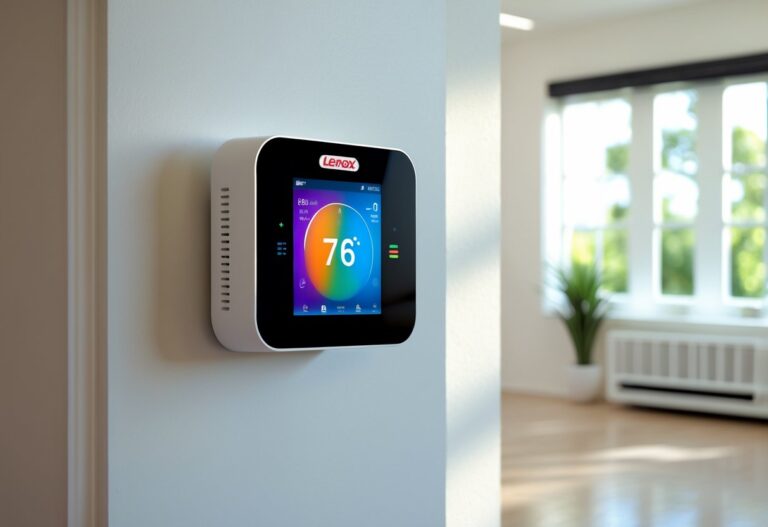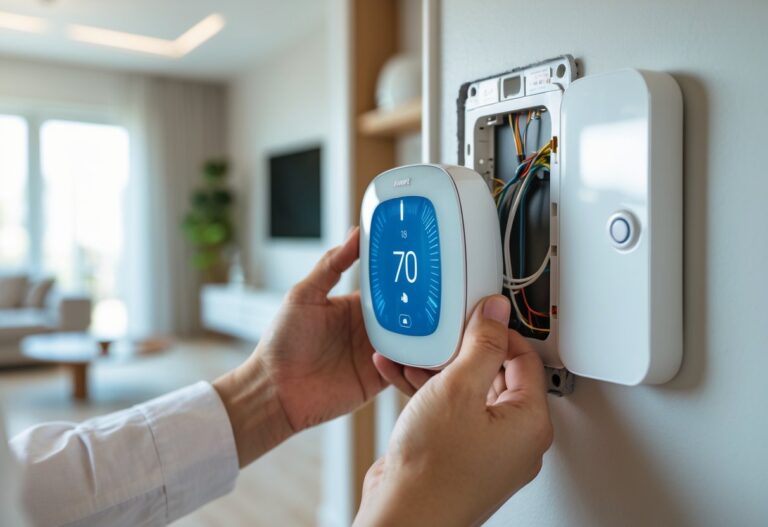Managing the temperature in your building shouldn’t feel complicated or wasteful. Smart thermostats for commercial buildings give you more control, help save money, and make day-to-day operations easier. With easy scheduling, remote access, and better energy use, these systems are changing how businesses manage their climate.

If you’re looking for fresh ways to cut costs, improve comfort, or boost efficiency, smart thermostats offer features that go beyond what older models provide. Many modern options can even connect to your building’s other systems, making them simple to use and manage, even across multiple locations.
Key Takeaways
- Smart thermostats make building temperature control easier and more efficient.
- Integration with other building systems helps you save energy and cut costs.
- Top models offer advanced features and simple maintenance.
Key Features of Smart Thermostats for Commercial Buildings
Smart thermostats in commercial buildings help manage heating and cooling with better control, advanced sensors, and easy scheduling. They make it possible to maintain comfort for everyone while saving energy and costs for your business.
Temperature Control and Comfort
Smart thermostats let you manage temperature in precise zones. You can adjust heating and cooling in different parts of your building, keeping some rooms warmer or cooler depending on your needs. This type of zone control improves comfort for staff and visitors.
Many models allow you to control settings from anywhere using Wi-Fi or an app. For example, you can make quick changes before employees arrive or after everyone leaves. The ability to adjust thermostat settings remotely can help avoid wasted energy and maintain a steady, comfortable environment.
Display screens on modern thermostats are large and easy to read. Some offer simple menus to reduce confusion and help everyone set the right temperature.
Sensors and Smart Response
Smart thermostats use built-in sensors to detect temperature, humidity, and even if people are present. These sensors let the system automatically adjust to fit your building’s actual occupancy and needs.
For example, if a room is empty, the thermostat can reduce heating or cooling to save energy. When people arrive, the smart thermostat can quickly return to a comfortable temperature. Wireless sensors can be placed in more than one area to improve accuracy and keep all zones at the correct temperature.
Some models offer proactive HVAC monitoring. They track system performance and can alert you to problems, so you can fix them before they affect comfort.
Programmable and 7-Day Flexible Scheduling
Programmable thermostats allow you to plan temperature settings throughout the week. With 7-day flexible scheduling, you can set different heating and cooling times for each day. This is useful if your business operates on varying schedules.
You can create multiple daily temperature periods, such as work hours, nights, and weekends. The thermostat will automatically shift the settings, so you do not have to remember to adjust it yourself. This kind of scheduling lowers energy costs without sacrificing comfort.
Some smart thermostats combine scheduling with remote access, so you can make last-minute changes if plans change. This gives you better control and supports both employee comfort and building efficiency.
Integration with Building Systems
When using smart thermostats in commercial buildings, the way they connect with larger building controls matters. Compatibility and integration help make energy use smarter and keep spaces comfortable.
Building Management System Compatibility
Smart thermostats often work with Building Management Systems (BMS). This means you can control your heating, cooling, and ventilation from one place. With BMS compatibility, you can adjust temperature settings for individual zones or whole floors.
Many modern smart thermostats are designed to match up with existing BMS protocols. This saves time and avoids expensive upgrades. For older buildings, some thermostats fit with current wiring, so you don’t need major rewiring.
Key benefits include:
- Remote access: Change settings from a computer or mobile device.
- Data tracking: Get reports on temperature and energy use.
- Scheduling: Program when areas should be heated or cooled.
You also get better control over comfort for tenants or workers.
Building Automation System Integration
Building Automation Systems (BAS) cover more than just HVAC. They often manage lighting, security, fire alarms, and more. Smart thermostats play an important part in these systems.
Integration lets you link temperature controls to other building functions. For example, the BAS can lower the heat or AC when a room is empty, saving energy. It can also alert you if a system needs service.
Features of BAS integration:
- Automated responses: Heating adjusts based on room occupancy.
- Centralized control: All building systems can be managed from a single dashboard.
- Efficiency: BAS can use data from thermostats to optimize energy consumption.
This level of automation helps you manage large commercial buildings more efficiently and reduces wasted energy.
Energy Management and Cost Savings
Smart thermostats can help lower your building’s energy bills, cut heating and cooling costs, and give you useful data to manage energy use. You can make informed decisions by using features like scheduling, real-time optimization, and detailed reports.
Reducing Energy Bills
Smart thermostats automatically adjust temperatures to reduce energy waste. By learning occupancy patterns, the system keeps rooms comfortable only when needed. When spaces are empty, the thermostat sets back heating or cooling to save money.
You can also control systems remotely through a phone or computer. This makes it easy to turn off heating and cooling in unused parts of the building. These features can lower overall energy bills by 10% to 15% for many businesses, depending on building size and use.
Smart thermostats can help keep energy bills steady and more predictable, which is important for managing monthly costs.
Heating and Cooling Optimization
Heating and cooling are often the biggest parts of your energy bill. Smart thermostats use sensors to detect when rooms are occupied. They can automatically turn down heating or cooling in areas that are not being used, reducing energy waste.
These systems let you set different temperatures for different areas (zones) of your building. For example, meeting rooms and storage areas can be set to different temperatures based on use. This helps keep everyone comfortable while saving money at the same time.
Some thermostats keep track of weather changes and adjust your building’s settings in real time. This steady optimization lowers heating and cooling bills without manual effort.
Energy Reports and Analytics
Smart thermostats provide detailed energy reports. These reports show exactly how much energy your building uses each day, week, or month. You can easily check which times of day use the most energy or see which parts of your building are using the most power.
With this data, you can identify trends or spot problems, like equipment or areas using more energy than expected. Many systems present this data in simple charts and graphs, making it easy to understand at a glance.
Reviewing these analytics helps you make smart choices. You can adjust settings or schedules based on real numbers, which helps you save money over time.
Save Money with Smart Scheduling
Smart scheduling lets you set precise times for heating and cooling to run. For example, you can make sure the system only turns on before the building opens and shuts off after everyone leaves. This reduces unnecessary use, directly cutting energy bills.
You can also program schedules for holidays or special events, so the system never runs when it isn’t needed. Some smart thermostats learn your building’s patterns on their own and fine-tune the schedule automatically, requiring less input from you.
Automatic scheduling also makes it easy to manage multiple locations or larger buildings. Changes can often be made from a single dashboard, streamlining management and reducing costs even further.
Advanced Technologies and Connectivity
Smart thermostats for commercial buildings use advanced features that improve how you control heating and cooling. These technologies make it easier to manage temperatures, save energy, and maintain comfort across different spaces.
Geofencing Technology
Geofencing technology lets your thermostat know when people enter or leave a building by using GPS or location data from smartphones.
When your staff or tenants move close to the building, the thermostat prepares the HVAC system to suit their preferred comfort settings. When everyone leaves, it automatically switches to an energy-saving mode. This helps prevent unnecessary heating or cooling when no one is present.
You set up geofencing in the thermostat’s app. Most commercial smart thermostats, like those from Honeywell or Ecobee, support this feature. Geofencing is especially useful in offices or retail spaces with regular work hours.
Below is a quick overview:
| Benefit | Description |
|---|---|
| Energy Savings | Reduces waste during off-hours |
| Convenience | No need for manual changes |
| Customization | Adjusts for different user schedules |
Voice Assistant Integration
Many modern commercial smart thermostats now work with voice assistants such as Amazon Alexa, Google Assistant, and Apple HomeKit.
With voice commands, you can adjust temperature settings, check the current status, or switch between modes without needing to touch the thermostat. This supports hands-free operation, which is helpful in busy work environments or for people with limited mobility.
To use this, connect the thermostat to your preferred assistant during setup. Most systems support simple phrases like “Set the temperature to 72 degrees” or “Turn off the heating.”
Below are some supported assistants:
- Amazon Alexa
- Google Assistant
- Apple HomeKit
- Some brands may also work with Microsoft Cortana
Integration makes it easier to manage the environment and can streamline building operations.
App Control and Remote Access
Remote control through apps is standard for commercial smart thermostats.
Most brands have dedicated apps like the Resideo app or Ecobee suite. These let you monitor conditions, adjust settings, and receive alerts about issues from anywhere, using a phone, tablet, or computer. This is useful for facility managers overseeing multiple sites.
You can also schedule temperature changes, track energy use, and set up maintenance reminders. Real-time access means problems can be addressed quickly, even outside business hours.
Remote access reduces the need for on-site visits and provides a clear overview of all your building’s climate controls. Features often include:
- Instant alerts for equipment problems
- Detailed energy usage reports
- Support for multiple users and locations
Having simple, remote management helps you save time and energy in daily operations.
Top Smart Thermostat Models for Commercial Use
Smart thermostats help your business control temperature more easily and can lead to energy savings. Some models have features made specifically for commercial settings, like remote control and scheduling. How a thermostat is built can affect how well it lasts and works in your buildings.
Honeywell Home T5 Smart Thermostat
The Honeywell Home T5 Smart Thermostat is designed for easy installation and flexible scheduling. You can set up 7-day or location-based schedules, which makes it simple to adjust temperatures around work hours. It works with most standard commercial heating and cooling systems.
Remote control is available through the Honeywell Home app, so you can change settings even when you aren’t on site. The T5 is also compatible with smart assistants like Alexa and Google Assistant. For businesses, this model helps balance comfort and energy use with clear, easy controls.
Key Features:
- 7-day scheduling or geofencing
- App-based remote access
- Works with Alexa and Google Assistant
- Simple touchscreen display
RTH8800WF2022
The RTH8800WF2022 is another strong option for commercial buildings. This model allows fine control of climate systems and can handle multiple stages for heating and cooling, which is often needed in larger commercial spaces.
With Wi-Fi connectivity, you can monitor and adjust the thermostat from anywhere. The device sends push notifications if there are issues or if it’s time for maintenance. Voice control is supported through popular digital assistants.
It has a modern touchscreen display that’s easy to read and use. Scheduling features help optimize your building’s energy use and keep bills under control.
Main Advantages:
- Compatible with complex HVAC systems
- Remote control via app
- Maintenance alerts
- Sleek, easy-to-use touchscreen
Manufacturing Considerations
When choosing smart thermostats for commercial use, manufacturing quality is important. Devices built for commercial settings should be durable and reliable, as they often work in harsher or more demanding environments compared to residential models.
Check if a thermostat offers certifications like ENERGY STAR or complies with building codes. Also consider whether replacement parts or technical support are easy to get. Some manufacturers, like Honeywell, have a long record of building products for commercial use, which can add peace of mind.
Consider:
- Durability and warranty
- Compliance with energy standards
- Ease of maintenance
- Support and spare parts availability
Maintenance and User Experience Enhancements
Smart thermostats give you new ways to keep your building comfortable and efficient. They also help make regular maintenance easier and improve your daily interactions with the system.
Filter Change Reminders
Changing HVAC filters on time is important for clean air and energy savings. Many smart thermostats now include automatic filter change reminders. These alerts use timers or sensors to track usage and tell you—by message, app notification, or screen display—when it’s time to check or replace a filter.
This feature helps you avoid manual tracking and reduces the risk of ignoring filter changes. You can set reminders to match your building’s needs, whether monthly, quarterly, or seasonally. Making filter changes on time can lower energy costs, maintain better indoor air quality, and extend equipment lifespan.
Here is a quick look at why filter change reminders matter:
| Benefit | Impact |
|---|---|
| Timely filter changes | Better air and HVAC health |
| Automated reminders | Fewer missed maintenance tasks |
| Energy efficiency | Lower utility bills |
User Interface and Ease of Use
Smart thermostats are designed with simple and clear controls. You can adjust settings from a touchscreen, mobile app, or web browser. Displays often use large fonts, quick-access menus, and clear labels that help anyone use the system without special training.
Mobile connectivity means you can check or change temperatures and schedules from anywhere. Some systems let you set permissions and user roles. This lets building managers control who can access certain features, helping keep the system secure but easy for staff to use.
The user interface also allows you to get real-time feedback on temperature and system status. Many platforms provide step-by-step guidance and alerts for common issues, so you always know what needs your attention. This helps reduce mistakes and keeps building climate control smooth and stress-free.
Frequently Asked Questions
Smart thermostats in commercial buildings offer features like remote access, compatibility with complex HVAC systems, and potential cost savings. They are designed to help you manage energy use more efficiently and make it simple to control multiple zones or locations.
What are the key advantages of using smart thermostats in commercial buildings?
You can save money on energy bills since smart thermostats can adjust heating and cooling based on usage patterns and occupancy. They often provide detailed usage reports, making it easier for you to track and manage energy use. Automated scheduling helps ensure heating and cooling are only active when needed.
How do commercial smart thermostats differ from residential models in terms of features and functionality?
Commercial smart thermostats support larger and more complex HVAC systems compared to most residential models. They can control more zones, monitor multiple sensors, and sometimes allow for centralized management across many units. Commercial models often include advanced analytics and reporting that help you understand and adjust building performance.
Can smart thermostats integrate with existing commercial HVAC systems, and if so, what is required for integration?
Most new commercial smart thermostats are designed to integrate with popular HVAC systems. You may need to check system compatibility and possibly use an interface or adapter. Professional installation is often recommended to make sure your thermostat communicates correctly with existing equipment.
What should be considered when choosing the most suitable smart thermostat for a large-scale commercial environment?
You should consider system compatibility, the number of zones you need to control, and if the thermostat offers remote access and management. Also, think about how easily the device integrates into your building automation system and whether it can handle the complexity of your setup. It is wise to look for models with solid technical support and regular software updates.
Are there smart thermostats that allow for remote management and monitoring in commercial settings?
Yes, many commercial smart thermostats include remote access features. These allow you to monitor and adjust settings from a computer or mobile device. Some brands also provide automatic alerts if there are issues with your HVAC system so you can quickly respond to problems.
What are some potential energy savings when implementing smart thermostats in commercial spaces?
Energy savings depend on the size of your building and how you use your systems, but studies and reports show that smart thermostats can help lower energy use by reducing waste. Automated adjustments for occupancy and scheduling help you avoid heating or cooling empty spaces, which can reduce your costs over time.

